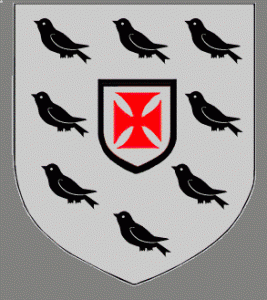There are many interpretations of the meanings of symbols on arms and shields. This is an attempt to decipher the meaning of the design of the Leftwich shield. The most commonly accepted meanings are given, but be aware that scholars question the reliability of placing historic significance on the designs of arms and crests.[1]
The arms of Richard de Winnington, who became the first Leftwich, were adapted from his father’s arms with the addition of the “cross pateé gules” which Richard used for difference.[2]
The Winnington Blazon of Arms (a written description in Heraldic terms):Argent, an inescutchion Sable, within an orle of martlets of the second.[3]
Argent (Silver) field (surface of the shield). Peace and sincerity.
Inescutchion. Small shield in center of primary shield (an escutchion is the outer shield). Claim of a prince to sovereignty; or marriage to an heiress of the family.
Sable (black) Constancy or grief.
Orle is a border that does not touch the edges of the shield.[4]
Martlets (mythical footless swallows who loved flight so much they never landed, therefore they didn’t need legs) are thought to represent the swift. Since the swift never lands this symbol has been used as a sign of a younger son who has no land of his own, therefore no place to rest. It may signify one who has to subsist by virtue and merit, not inheritance. It is also thought that this is an emblem of one who has been on a pilgrimage to the Holy Land.[5]
Of the second refers to the second color in the description (sable) to avoid repetition.
Cross Pateé (or cross formee) designates a military honor.
Gules (red). Warrior or martyr; Military strength and magnanimity.
The shape of the escutchion was determined by time period and geographic region, and was not part of the official blazon.
[1] http://www.fleurdelis.com/meanings.htm
[2] The Leftwich Heritage, Spring 2000, Leftwich Coat of Arms is Adopted by LHA, Lloyd L. Stone, Jr., pp. 8.
[3] J.P. Earwaker, History of Sandbach, pp. 208.
[4] “Heraldry,” Microsoft® Encarta® Encyclopedia 2000.
[5] Stefan Oliver, An Introduction to Heraldry, Quantum Books, pp. 70.
Contributed By Mike Starr, Lloyd Stone, Derek Whitfield

